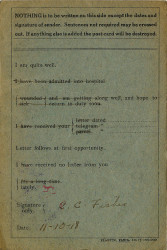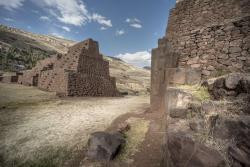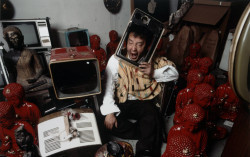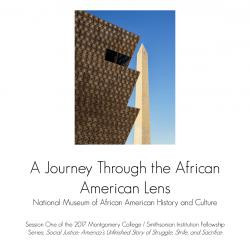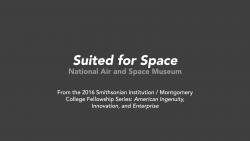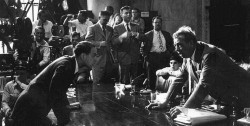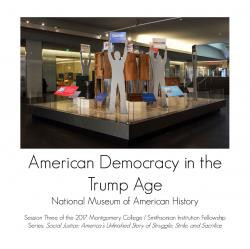Tess Porter
User Experience Strategist (she/her)
Smithsonian Office of Educational Technology
I'm the User Experience Strategist at the Smithsonian Office of Educational Technology. Here, I focus on the use of digital museum resources to support teaching and learning. My work draws on my experience as a museum educator, digital analyst, usability researcher, and content designer. I hold a B.A. in Anthropology and a B.A. in Art History from University Colorado Boulder, and an M.S. in Museums and Digital Culture with an Advanced Certificate in User Experience at Pratt Institute.
Tess Porter's collections
The Classical Origin of Iconic American Symbols
<p>In this student activity, analyze how and why iconic symbols of America, such as the Capitol Building and the United States Seal, were inspired by Greek and Roman art and architecture. </p>
<p>Explores the big ideas:</p>
<p></p>
<ul><li>How were symbols of America influenced by those of Ancient Greece and Rome? </li><li>What might this desire to associate America with historic, successful democracies say about early American hopes for their new nation?</li></ul><p></p>
<p>Includes: architecture, a seal, portraiture, a video, a primary source letter, discussion questions, and an opportunity to learn more through the full digitized text of "The Ruins of Palmyra," a publication that heavily inspired early American neoclassical architecture.</p>
<p>Keywords: greece, symbolism, classic, classical</p>
 Tess Porter
Tess Porter
12
Shoes: Exploring Culture, History, Place, and Innovation
<p>Teacher's guide for using shoes to explore culture, history, place, and innovation. Includes images of thirty shoes and three different strategies, located at the end of the collection, for using these objects in the classroom. </p>
<p>Strategies include: a small-group object analysis activity; a poster, "If You Walked in My Shoes," introducing students to basic primary source analysis questions through six pairs of shoes; and a vocabulary exercise for ESL learners.</p>
 Tess Porter
Tess Porter
33
Letter Writing and Censorship in World War I
<p>This activity has students investigate experiences of servicemen in World War I through primary sources - censored U.S. Army mail postcards and envelopes. Students will compare and contrast these primary sources to examine how censorship affected communication between servicemen and their loved ones, while building an understanding of how U.S. Army mail censorship was implemented and why it was necessary. Using two Project Zero Visible Thinking routines, this activity is designed to spark further inquiry into World War I and the experiences of servicemen. The activity ends with an opportunity to learn more by examining a parody of the form postcard written by a British serviceman in his diary.</p>
<p>Information on how to use this collection in the classroom can by found by clicking <em>Read More »</em>. </p>
<p>This collection was created in conjunction with the National Postal Museum's "My Fellow Soldiers: Letters from World War I" teacher workshop (July 19, 2017). It focuses on two of the many postcards from <a href="https://learninglab.si.edu/collections/my-fellow-soldiers-postcards-from-world-war-i/HPrCVWkR1wqjpK3k#r" target="_blank">this topical collection</a> to demonstrate its use in a secondary classroom. #NPMTeacherPrograms</p>
<p>Keywords: WWI, WW1, the great war, army, military, soldiers, soldier, primary source, project zero, thinking routine</p>
 Tess Porter
Tess Porter
9
Inka Architecture: Teaching Resources
<p>This topical collection gathers teaching resources on Inka architecture, focusing on building methods and architectural symbolism in Cusco, capital of the Inka Empire. These resources explore the symbolic layout of Cusco as well as the architecture of five specific structures: Saqsaywaman (upper temple of the sun), Hatunrumiyoc (a wall, once part of the palace of Inka Roca), the Qorichanka (lower temple of the sun), and the Double Jamb Doorway (a sacred entryway). Includes video interviews with archaeologists, interactive 3D models, and the exhibition website for "The Great Inka Road: Engineering an Empire." Resources also explore the continuing importance of these structures in Cusco today, both in terms of environmental stability and continuing cultures.</p>
<p>Keywords: inkan, inca, incan, archaeologist, stonework, continuing legacy, peru, symbol, religion, ancient civilization, world history, culture, cuzco, andes, saksaywaman, qurikancha, archaeology, pre-columbian, latin america, south america, ruins</p>
 Tess Porter
Tess Porter
23
New Orleans & Place
<p>Includes iconic people, places, and things associated with New Orleans. In the classroom, these resources can be used by students to investigate two essential questions: How do you define New Orleans as a place? What does it mean to be a New Orleanian? </p><p>Supporting questions and activity implementation ideas are located under this collection's Information (i) button.</p><p>Keywords: louisiana</p>
 Tess Porter
Tess Porter
28
Asian Pacific American Artists
<p>This topical collection includes resources related to Asian Pacific American artists, including individuals who work in photography, sculpture, painting, installation art, video art, landscape design, furniture design, jewelry and architecture. This collection includes portraits of the artists, artwork, articles, videos with experts, and related Smithsonian Learning Lab collections. </p>
<p>Teachers and students may use this collection as a springboard for classroom discussions including biographies of Asian Pacific American artists, art analysis, and historical context. This collection is not comprehensive but rather provides a launching point for research and study. </p>
<p><em>This Smithsonian Learning Lab collection received Federal support from the Asian Pacific American Initiatives Pool, administered by the Smithsonian Asian Pacific American Center. </em> </p>
<p>Keywords: Nam June Paik, Korean American, Roger Shimomura, Japanese American, Maya Lin, Vietnamese American, CYJO, Cindy Hwang, Isamu Noguchi, Yasuo Kuniyoshi, Akio Takamori, George Nakashima, visual art<br /></p>
<p>#APA2018</p>
 Tess Porter
Tess Porter
124
Langston Hughes: Examining Portraiture
<p>This teacher's guide provides portraits and analysis questions to enrich students' examination of Langston Hughes, an American poet, novelist, playwright, and activist. Includes the video "Defining Portraiture: How are portraits both fact and fiction?" and the National Portrait Gallery's "<em>Reading" Portraiture Guide for Educators, </em>both of which provide suggestions and questions for analyzing portraiture. Also includes "The Music in Poetry" lesson plan and website, which connect the rhythm of blues stanzas to Langson Hughes' poetry and may be used as a lesson extension.</p>
<p>Consider:</p>
<ul><li>What do these portraits have in common? How are they different?</li><li>How are these portraits both fact and fiction?</li><li>How do these portraits reflect how they wanted to be seen, or how others wanted them to be seen? Consider for what purpose these portraits were created.</li><li>Having read one of his poems, does the portrait capture your image of Langston Hughes? Why, or why not?</li><li>If you were creating your own portrait of Langston Hughes, what characteristics would you emphasize, and why?</li></ul><p>Keywords: missouri, mo, poetry, jazz, blues</p>
 Tess Porter
Tess Porter
10
Walt Whitman: Examining Portraiture
<p>This teacher's guide provides portraits and analysis questions to enrich students' examination of Walt Whitman, an American poet, essayist, and journalist. Includes the video "Defining Portraiture: How are portraits both fact and fiction?" and the National Portrait Gallery's "<em>Reading" Portraiture Guide for Educators, </em>both of which provide suggestions and questions for analyzing portraiture. Also includes "A Close, Intimate Look at Walt Whitman," an article about the final portrait in this collection that may be used as a lesson extension.</p>
<p>Consider:</p>
<ul><li>What do these portraits have in common? How are they different?</li><li>How are these portraits both fact and fiction?</li><li>How do these portraits reflect how he wanted to be seen, or how others wanted him to be seen? Consider for what purpose these portraits were created.</li><li>Having read one of his poems, does the portrait capture your image of Walt Whitman? Why, or why not?</li><li>If you were creating your own portrait of Walt Whitman, what characteristics would you emphasize, and why?</li></ul><p>Keywords: new york, ny, leaves of grass, humanist, writer</p>
 Tess Porter
Tess Porter
9
Social Justice: National Museum of African American History and Culture Resources
<p>This collection previews the first seminar of the 2017 Montgomery College / Smithsonian Institution Fellowship seminar series, <em>A Journey Through the African American Lens</em>. Five National Museum of African American History and Culture staff members will lead this event: Kinshasha Holman Conwill, Dr. Rex Ellis, Dr. Jacquelyn Serwer, Dr. Michèle Gates Moresi, and Mary Elliott.</p>
<p>Resources and reflection questions included in this collection have been chosen by the presenters for participants to explore, consider, and answer before the seminar itself. Fellows will be asked to discuss their answers to the reflection questions during the seminar. </p>
<p>#MCteach</p>
 Tess Porter
Tess Porter
41
What Makes You Say That?: Civil War Photograph
<p>Using the Project Zero Visible Thinking routine "What makes you say that?," students will investigate a photograph from the Civil War taken by the studio of Mathew Brady, one of the most prominent American photographers of the 19th century. The Civil War was the first major war captured on camera and photographs, like this one, played a pivotal role in shaping public perceptions of the conflict.</p>
<p>This activity can be used as an entry point into studying soldiers' experiences during the Civil War, photography's effect on public perspectives about war, and more. Resources to extend this activity include: a Smithsonian American Art Museum lesson plan investigating this and other photographs from the Civil War, a blog post discussing connections between Civil War photography and President Abraham Lincoln, a Smithsonian Magazine article about Civil War photographer Alexander Gardner, a Learning Lab collection on Alexander Gardner's <em>Photographic Sketchbook of the War, </em>and an article discussing the National Portrait Gallery's recent exhibition <em>The Face of Battle: Americans at War, 9/11 to Now</em>.</p>
<p><em>Keywords: photo, battlefield, inquiry strategy</em></p>
 Tess Porter
Tess Porter
8
Portrait Analysis: Lili'oukalani
<p>In this activity, students will analyze a portrait of Lili'oukalani (1838-1917), the last monarch of the Kingdom of Hawaii. Queen Lili'uokalani came to the throne after her brother's death in 1891 and ruled until 1893 when, to avoid bloodshed, she surrendered to a coup led by American business leaders. Opportunities to learn more include other portraits of Lili'uokalani, including one taken when she was 15, an article about her life and the annexation of Hawaii, and more.</p>
<p>This activity can be used as an entry point into studying Lili'uokalani's life and achievements, Hawaiian annexation, Hawaiian history and culture, and more. This activity opens with questions from the National Portrait Gallery's<em> "Reading" Portraiture Guide for Educators</em> and ends with a Project Zero Think / Puzzle / Explore routine; the full portraiture guide and routine instructions are located at the end of the collection.<br /></p>
<p><em>This Smithsonian Learning Lab collection received Federal support from the Asian Pacific American Initiatives Pool, administered by the Smithsonian Asian Pacific American Center.</em></p>
<p>Keywords: liliuokalani, hawai'i, polynesian, pacific islander</p>
<p>#APA2018 #BecauseOfHerStory</p>
 Tess Porter
Tess Porter
11
Designing a Better Voting Machine: 1880s to Today
<p>Objects are time capsules; they embody values, aspirations, or problems of a particular time and place and mark a stage of technological evolution. This student activity examines voting machines used in U.S. elections over more than a century. Looking closely and understanding the historical objects’ design evolution will inform students’ design of new machine intended to overcome barriers to voting in today's elections. </p>
<p>The first five images are voting machines from the late 1800s to the early 2000s. Students will explore their parts, purposes, and complexities, then read the Washington Post article "Broken machines, rejected ballots and long lines: voting problems emerge as Americans go to the polls." Finally, students will design (and may prototype) a voting machine.<br /></p>
<p>This collection incorporates two Project Zero Agency by Design routines: <em></em><a href="https://learninglab.si.edu/collections/agency-by-design-voting/xf6JuBhCB1u29e8h/#r/517111">Parts, Purposes, Complexities</a>, a routine for looking closely; and <a href="https://learninglab.si.edu/collections/agency-by-design-voting/xf6JuBhCB1u29e8h/#r/517112">Imagine If...</a>, a routine for finding opportunity. Questions in each routine are open-ended and should be used to spark peer discussion in small groups or as a class. For more information on how to use and facilitate each routine, see their resource tiles at the end of the collection, as well as the <a href="http://www.agencybydesign.org/">Agency by Design website</a>.</p>
<p><em>Keywords: vote, voter, maker, making </em></p>
 Tess Porter
Tess Porter
13

